
2024.03.22
Panasonic Group People
Entirely New Concepts and Ideas to Create a
Travel Experience Unique to Panasonic: Yuya Yamasaki
Series:
Valuing the Customer’s Perspective to Unlock 

A UX designer leading the creation of user value
Yuya Yamasaki
Business Planning Office
HMI Systems Business Division
Panasonic Automotive Systems Co., Ltd.
Joined the company in 2005. He was previously in charge of software/system development and product planning mainly for IP telephones in business communication projects. He then incorporated elements of UX design into product planning processes. Following roles in product planning and development in facial recognition projects, he moved to his current role in June 2023, where he uses his experience in product planning and UX design.
Independently learning UX design to reinforce product planning
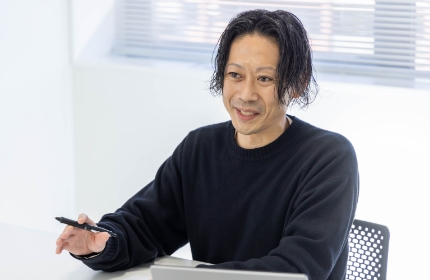
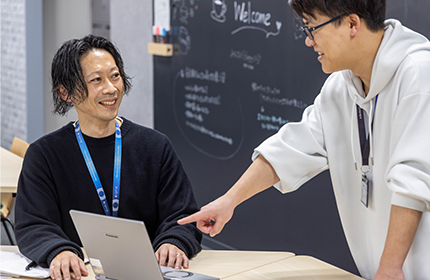
A meeting with an employee from the Business Planning Office
As we as a society shift toward electric vehicles, neither drivers nor passengers are seeking value exclusively in the vehicle’s driving performance. Rather, their needs are diversifying to include experiential value—that is, the services they can use through the car and the in-car environment. For us to provide this added value, it is essential that we develop in-vehicle experiences and charms from the driver’s perspective. My role is to incorporate aspects of UX design from the product planning stage and to design experiences that customers can have through related products and services. I first realized the importance of UX design when I took part in a collaborative industry-academia project. This spurred me to devote myself to independently learning about UX design—an approach that values the customer’s perspective—communicating its importance in-house, and incorporating its benefits into my own work in product planning and development.
In January this year, Panasonic Automotive Systems (PAS) exhibited(Japanese only) at Tokyo Auto Salon 2024, Japan’s largest custom auto show. Our aim was to create a multi-purpose, high-value-added in-vehicle environment in which time spent in the vehicle could be adapted in line with the purpose of travel and customers’ specific needs. Making full use of Panasonic technologies, we created a luxurious environment that featured ideal visuals, audio, vibration, lighting, and aromas for a unique experience. In the rear seating area, we installed a 55-inch display and 3D high-resolution audio speakers for a highly immersive setting. One vehicle we exhibited was for business executives, with an environment conducive to a 10-minute refreshing power nap in-between jobs. The other vehicle was geared toward VIPs, including international visitors, aiming to provide them with a sense of excitement through visuals of sightseeing spots and sports. Based on our desire to create valuable experiences and a comfortable interior, we named the concept car WELL Cabin.
Through the exhibit, our aim was to attract potential business partners for new projects and gauge customers’ reactions through real concept cars. Many visitors to our booth reacted positively to the impressive screens and the immersive experience that the space provided. As a result, we have already received inquiries from more than ten companies about potential collaborations. It was a great start for us to 2024, a year in which we are aiming to launch various new businesses. By taking the initiative in showcasing the experiential value we can provide for customers in this way, we will work to develop new businesses with car manufacturers, B2B customers, and MaaS partners, for example.
*Mobility as a Service (MaaS) businesses: Businesses that provide mobility services such as hire cars and transport to and from sightseeing spots.
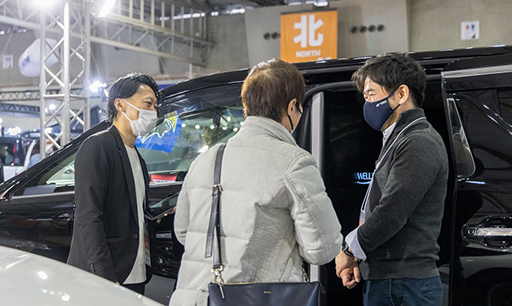
Describing WELL Cabin to a customer at Tokyo Auto Salon 2024
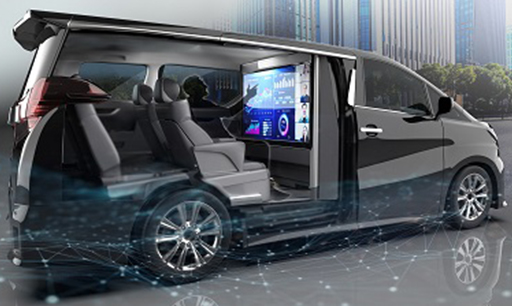
An example of an in-vehicle environment for business executives. The air conditioning system uses aromatic oils to create a relaxing atmosphere. “Our aim is to propose the ultimate in-vehicle comfort.”
Finding answers through repeated hypotheses and verifications
Our exhibit at Tokyo Auto Salon 2024 required a diverse team of individuals from different roles and with various skills and career backgrounds. I was responsible for managing the team and leading concept development. Our aim was to create new value using new methods, and to communicate this value through new means. We needed to work from the ground up, and there were some difficult periods in which we made little progress through our discussions. However, we were able to overcome these difficulties by forthrightly sharing our thoughts and ideas as a team, and defining the purpose of our exhibit to ensure we were all on the same wavelength. Looking back, it was thanks to the diversity of our team that we were able to come up with entirely new concepts and ideas, and ultimately develop these into tangible results.
There is no definitive answer as to how to go about the value creation process, nor is there a clear answer as to what that value should be. It’s important, therefore, to form a hypothesis, propose it to the customer, verify the effects, and learn from the outcome before repeating the process again. This approach and a strong ambition to create new value is key. This is the UX design approach that I was able to bring to the project.
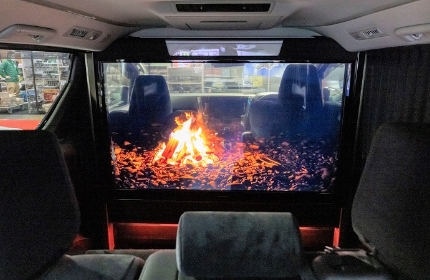
The 55-inch display as seen from the rear seats. “It’s actually bigger than the TV I have at home… It was great to be able to see the surprise on visitors’ faces first-hand.”
Moving forward, our aim is to further expand the WELL Cabin concept and commercialize and scale the business. With the increasing development of software-defined vehicles, in which vehicle functions and capabilities can be updated, we will be able to maintain constant post-sale touchpoints with our customers. This is a huge opportunity for us to analyze a vehicle’s driving data and use our findings to update the software to enhance UX for customers. The Panasonic Group’s sensing technologies can be used to create this UX improvement cycle, and combining this with the technologies we have accumulated in home appliances will enable us to create a unique future. I will continue to take on new challenges based on the belief that we can achieve this goal.
The content in this website is accurate at the time of publication but may be subject to change without notice.
Please note therefore that these documents may not always contain the most up-to-date information.
Please note that German, French and Chinese versions are machine translations, so the quality and accuracy may vary.





